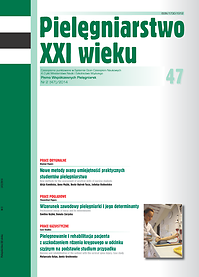Methods of assessing pain in newborns and infants
DOI:
https://doi.org/10.12923/Keywords:
postoperative pain, pain assessment, newborn, infant, pretermAbstract
METHODS OF ASSESSING PAIN IN NEWBORNS AND INFANTS
Postoperative pain is an unpleasant experience, which can reduce patient’s quality of life, prolong recovery process, and increase the duration of hospital stay and costs of hospitalization. To assess pain properly, special tools should be used. The biggest challenge for healthcare-professionals is to assess pain in children younger than 3 years old, who can’t speak or aren’t able to assess pain intensity. Therefore, the staff who takes care of child, should know the basic tools for monitoring pain. The aim of the study is to discuss several scales especially adapted for this age group and the presentation of the most commonly used analgesic drugs.
References
1. Stevens B. Pain assessment and management in infants with cancer. Pediatr. Blood Cancer .2007; 49: 1097-1101.
2. Garra G, Singer AJ, Taira BR, et al. Validation of the Wong-Baker FACES Pain Rating Scale in Pediatric Emergency Department Patients. Acad. Emerg. Med. 2010; 17(1): 50-54.
3. Trudeau JD, Lamb E, Gowans M, Lauder G. A prospective audit of postoperative pain control in pediatric patients. AORN. Journal. 2009; 90(4): 531-542.
4. Lönnqvist PA, Morton NS. Postoperative analgesia in infants and children. Br. J. Anaesth. 2005; 95(1): 59-68.
5. Fuller BF. Infant behaviors as indicators of established acute pain. JSPN. 2001; 6(3): 109-115.
6. Prevention and management of pain in the neonate: an update. Pediatrics. 2006; 118 (5): 2231-2241.
7. Pasero C. Pain assessment in infants and young children: neonates. A.J.N. 2002; 102:61-64.
8. Schiavenato M. Facial expressions and pain assessment in the pediatric patient: the primal face of pain. JSPN. 2008; 13(2): 89-97.
9. Stevens B, Johnston C, Petryshen P, et al. Premature Infant Pain Profile: development and initial validation. Clin. J. Pain. 1996; 12(1): 13-22.
10. McNair C, Ballantyne M, Dionne K, et al. Postoperative pain assessment in the neonatal intensive care unit. Arch. Dis. Child. Fetal. Neonatal. Ed. 2004; 89(6): F537-F541.
11. Lawrence J, Alcock D, McGrath P, et al. The development of a tool to assess neonatal pain. Neonatal Network. 1993; 12(6): 59-66.
12. van Dijk M, de Boer JB, Koot HM, et al. The reliability and validity of the COMFORT scale as a postoperative pain instrument in 0 – to 3-year-old infants. Pain. 2000; 84(2-3): 367-377.
13. Merkel SI, Voepel-Lewis T, Shayevitz JR, et al. The FLACC: a behavioral scale for scoring postoperative pain in young children. Pediatr. Nurs. 1997; 23(3): 293-297.
14. Merkel S, Voepel-Lewis T, Malviya S. Pain assessment in infant and young children: the FLACC scale. A.J.N. 2002; 102(10): 55-57.
15. Debillon T, Zupan V, Ravault N, et al. Development and initial validation of the EDIN scale, a new tool for assessing prolonged pain in preterm infants. Arch Dis Child Feta. Neonatal Ed 2001;85: F36 – F41
16. Kohut SA, Riddell RP. Does the Neonatal Facial Coding System differentiate between infants experiencing pain-related and non-pain-related distress? J Pain 2009;10(2): 214– 220.
17. Good practice in postoperative and procedural pain management, 2nd edition. Association of Paediatric Anaesthetists of Great Britain and Ireland. Paediatr. Anaesth. 2012; 22(suppl 1): 1-79.
18. Duggan ST, Scott LJ. Intravenous paracetamol (acetaminophen). Drugs. 2009; 69(1): 101-113.
19. Verghese ST, Hannallah RS. Acute pain management in children. J. Pain. Res. 2010; 15(3): 105-123.
20. Anand KJS. Pharmacological approaches to the management of pain in the neonatal intensive care unit. J. Perinatol. 2007; 27(suppl 1): S4-S11.
Downloads
Published
Issue
Section
License
Copyright (c) 2014 Ilona Rozalska-Walaszek, Anna Aftyka (Autor)

This work is licensed under a Creative Commons Attribution 4.0 International License.




